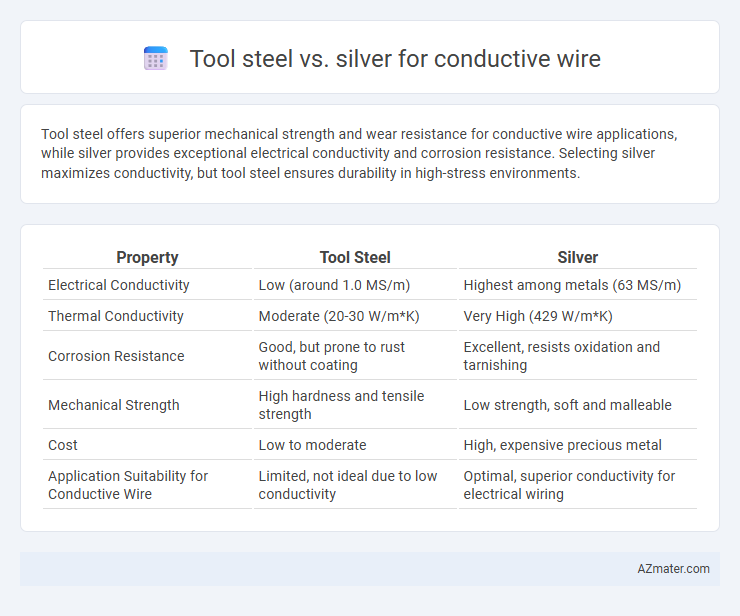Tool steel offers superior mechanical strength and wear resistance for conductive wire applications, while silver provides exceptional electrical conductivity and corrosion resistance. Selecting silver maximizes conductivity, but tool steel ensures durability in high-stress environments.
Table of Comparison
| Property | Tool Steel | Silver |
|---|---|---|
| Electrical Conductivity | Low (around 1.0 MS/m) | Highest among metals (63 MS/m) |
| Thermal Conductivity | Moderate (20-30 W/m*K) | Very High (429 W/m*K) |
| Corrosion Resistance | Good, but prone to rust without coating | Excellent, resists oxidation and tarnishing |
| Mechanical Strength | High hardness and tensile strength | Low strength, soft and malleable |
| Cost | Low to moderate | High, expensive precious metal |
| Application Suitability for Conductive Wire | Limited, not ideal due to low conductivity | Optimal, superior conductivity for electrical wiring |
Introduction to Conductive Wire Materials
Conductive wire materials primarily rely on metals with high electrical conductivity, such as silver, which offers the highest conductivity among all metals, making it ideal for minimal energy loss in electrical applications. Tool steel, while known for its strength and durability, has significantly lower conductivity and is typically unsuitable for efficient electrical conduction. Selection between silver and tool steel depends on balancing electrical performance needs against mechanical strength and cost considerations.
Overview of Tool Steel and Silver
Tool steel is an alloy primarily composed of iron, carbon, and various additives such as tungsten, molybdenum, and vanadium, renowned for its hardness, durability, and resistance to abrasion, making it ideal for cutting tools and mechanical applications. Silver, a precious metal, exhibits the highest electrical conductivity of all metals, exceptional thermal conductivity, and excellent corrosion resistance, which makes it a superior choice for manufacturing conductive wires and electrical contacts. While tool steel offers mechanical strength and wear resistance, silver is preferred for conductive wires due to its unmatched ability to efficiently transmit electrical current with minimal resistance.
Electrical Conductivity: Tool Steel vs Silver
Silver exhibits the highest electrical conductivity among metals, with a conductivity of approximately 63 x 10^6 S/m, making it ideal for conductive wire applications requiring minimal resistance. Tool steel, by contrast, has significantly lower electrical conductivity, generally less than 1 x 10^6 S/m, due to its alloy composition optimized for strength rather than conductivity. This vast difference in electrical conductivity fundamentally limits tool steel's effectiveness as a conductive wire compared to silver, which offers superior current-carrying capacity and minimal energy loss.
Mechanical Properties and Durability
Tool steel offers superior mechanical properties such as high tensile strength, hardness, and wear resistance compared to silver, making it more durable for applications requiring physical robustness. Silver, while exhibiting excellent electrical conductivity, has lower mechanical strength and is prone to deformation under mechanical stress. The durability of tool steel ensures longer lifespan and reliability in environments with mechanical wear, whereas silver wires may require protective coatings to enhance durability despite their conductive advantage.
Corrosion Resistance Comparison
Tool steel offers superior corrosion resistance compared to silver when exposed to harsh industrial environments, thanks to its alloying elements like chromium that form protective oxide layers. Silver, while highly conductive, is prone to tarnishing and corrosion, particularly in sulfur-containing atmospheres, which can degrade its conductivity over time. For applications demanding both conductivity and long-term durability, tool steel coated or alloyed for conductivity often outperforms silver in minimizing corrosion-related failures.
Cost Analysis: Tool Steel vs Silver
Tool steel offers a significantly lower cost compared to silver, making it a more economical choice for conductive wire applications where budget constraints are critical. Despite silver's superior electrical conductivity, its high material cost and price volatility often outweigh its performance benefits in large-scale or budget-sensitive projects. Cost analysis indicates that tool steel, while less conductive, provides a durable and affordable alternative for conductive wiring solutions requiring moderate conductivity and high strength.
Applications in Electrical Engineering
Tool steel offers high mechanical strength and wear resistance but has relatively low electrical conductivity, making it less suitable for high-performance conductive wires in electrical engineering. Silver exhibits the highest electrical conductivity among metals, ensuring efficient current flow and minimal energy loss, which is crucial in applications like high-frequency signal transmission and precision electronics. Therefore, silver is preferred for conductive wires in sensitive electrical components, while tool steel may be reserved for structural elements requiring durability alongside conductivity.
Thermal Conductivity Differences
Tool steel exhibits significantly lower thermal conductivity compared to silver, with values around 15-25 W/m*K versus silver's exceptional 429 W/m*K at room temperature. This stark difference impacts heat dissipation efficiency in conductive wires, where silver's superior thermal conductivity enables faster heat transfer and reduces the risk of overheating. Consequently, silver wires maintain lower operating temperatures under electrical loads, enhancing performance and longevity in high-power applications.
Availability and Sustainability
Tool steel is widely available due to its extensive use in industrial applications, making it a cost-effective option for conductive wires, but its production involves significant energy consumption and environmental impact. Silver, though less abundant and more expensive, offers superior conductivity and can be recycled efficiently, contributing to better sustainability in conductive wire applications. The choice between tool steel and silver hinges on balancing availability, cost, and the environmental benefits linked to recycling and resource extraction.
Conclusion: Choosing the Right Material
Tool steel offers exceptional strength and durability but has relatively high electrical resistivity compared to silver, which is renowned for its superior conductivity and corrosion resistance. Silver remains the ideal choice for conductive wires where maximum electrical efficiency and low resistance are critical, despite its higher cost and softer nature. Selecting the right material depends on balancing performance needs, environmental conditions, and budget constraints, with silver preferred for high-performance wiring and tool steel suited for applications requiring mechanical strength.

Infographic: Tool steel vs Silver for Conductive wire
 azmater.com
azmater.com